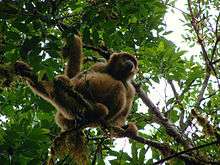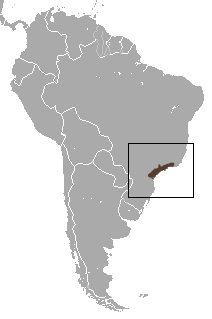Southern muriqui
The southern muriqui (Brachyteles arachnoides) is a muriqui (woolly spider monkey) species endemic to Brazil. It is found in the Brazilian states of Paraná, São Paulo, Rio de Janeiro, Espírito Santo and Minas Gerais. This New World monkey is known locally as mono carvoeiro, which translates to "charcoal monkey".[3][4]
| Southern muriqui[1] | |
|---|---|
 | |
| Scientific classification | |
| Kingdom: | Animalia |
| Phylum: | Chordata |
| Class: | Mammalia |
| Order: | Primates |
| Suborder: | Haplorhini |
| Infraorder: | Simiiformes |
| Family: | Atelidae |
| Genus: | Brachyteles |
| Species: | B. arachnoides |
| Binomial name | |
| Brachyteles arachnoides (É. Geoffroy, 1806) | |
 | |
| Southern muriqui range | |
Muriquis are the largest New World monkeys and largest non-human native primates in the Americas. Male muriquis have a head-body length of 55–78 cm (21.5–30.5 in), with a tail of 74–80 cm (29–31.5 in) and a body weight of 9.6–15 kg (21–33 lb). Females have a head-body length of 46–63 cm (18–25 in), a tail length of 65–74 cm (25.5–29 in) and a body weight of 8–11 kg (18–24 lb).[5][6] The tails are fully prehensile.
The southern muriqui, B. arachnoides, has a solid black face, distinguishing it from the northern species, B. hypoxanthus, which has a black face mottled with pink.
This species is considered endangered because of habitat destruction, hunting pressures, and historic population declines. Only two captive populations of the southern muriqui exist. They are housed at the zoo of Curitiba and at the zoo of Sorocaba, Brazil. The latter is located 80 km from the only long-term investigation of the southern muriqui in continuous forest, the Carlos Botelho State Park. The wild population was estimated at 1,300 in 2005.[7]
References
- Groves, C. P. (2005). "Order Primates". In Wilson, D. E.; Reeder, D. M (eds.). Mammal Species of the World: A Taxonomic and Geographic Reference (3rd ed.). Johns Hopkins University Press. p. 151. ISBN 978-0-8018-8221-0. OCLC 62265494.
- Talebi, M.; Melo, F.; Rylands, A.B.; Ferraz, D. da S.; Ingberman, B.; Mittermeier, R.A.; Martins, M.; Jerusalinsky, L. (2019). "Brachyteles arachnoides". IUCN Red List of Threatened Species. 2019: e.T2993A17927228. Retrieved 7 March 2020.
- APA – Serra do Mar Archived 2011-07-06 at the Wayback Machine. ambiente.sp.gov.br
- Parque Estadual da Ilha do Cardoso: modelo de Gestão Ambiental Archived 2011-01-07 at the Wayback Machine. ambiente.sp.gov.br
- Southern muriqui videos, photos and facts – Brachyteles arachnoides Archived 2009-12-24 at the Wayback Machine. ARKive (2006-02-13). Retrieved on 2012-06-11.
- southern muriqui (primate) – Britannica Online Encyclopedia. Britannica.com. Retrieved on 2012-06-11.
- Melo, F. R. & Dias, L. G. (2005). "Muriqui populations reported in the literature over the last 40 years". Neotropical Primates. 13: 19–24.
External links
| Wikispecies has information related to Southern Muriqui |
- Pró-Muriqui Association – Conservation Research of southern muriqui (Brachyteles arachnoides)
- Conservation of the Muriqui from Brazil
